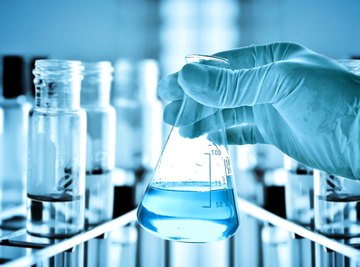
To be able to calculate the concentration of a solution is one of the most basic skills required of a scientist. Without knowing how much of a substance you're working with, you have no control over the reactions you're conducting.
Concentration of a Solution: Definition
Concentration of a solution is primarily reported in molarity or moles per liter. The abbreviation for molarity is M and the concentration units are mol/L.
The definition of molarity means that you can find the molarity of a solution if you know the total number of moles of the solute and the total volume of the solution. So, in order to calculate the concentration of a solution (in molarity), you need to divide moles of solute by total volume.
Tips
Concentration formula: To find the molar concentration of a solution, simply divide the total moles of solute by the total volume of the solution in liters.
Calculating the Molar Concentration of a Solution
Say you have 10 moles of NaCl, and your total volume of solution is 5 L. To find the molarity of this solution, you need to divide the total moles of solute (NaCl) by the total volume:
This means that your 5 L solution which contains 10 moles of NaCl is a 2 M NaCl solution. Here, "M" is said aloud as "molar."
What if you have a solution that contains 10 grams of NaCl in 5 L of solution?
To find the concentration of this new solution you need to convert from grams to moles. This requires the use of the molar mass (given in grams/mole) of the NaCl. The molar mass of a substance is found by adding together the molar mass of the individual components. For NaCl, the two components are sodium and chloride.
To find the molar mass of either of them, you need to look under their symbols on the periodic table. The molar mass of sodium is 22.99 g/mol, and the molar mass of chlorine is 35.45 g/mol. Added together, this gives you the molar mass of NaCl, which is 58.44 g/mol.
Now, you can find the concentration of a 5 L solution that contains 10 grams of NaCl.
Begin by converting grams into moles:
Next, you need to divide the number of moles by the total volume to find the concentration:
This means that if you have 10 grams of NaCl in a 5 L solution, you will have a 0.034 M solution of NaCl.
What if you have a solution which contains 1,000 milligrams of NaCl in 5 L of solution?
In this case, you need to first convert from milligrams to grams. There are 1,000 milligrams in 1 gram.
So:
Now that you know that 1,000 milligrams corresponds to 1 gram, you can convert grams into moles using the molar mass:
Finally, you can take the number of moles and divide by the total volume:
Thus, 1,000 grams of NaCl in 5 L of total solution is the same as a 0.0034 M solution of NaCl.
General Equations For Finding Concentration
The following shows a generalized version of the steps shown above or "concentration formula."
Given moles of solute and liters of solution, molarity is calculated by:
Given the amount of solute in grams, the following equation gives concentration:
Given the amount of solute in milligrams, the following equation gives concentration:
References
About the Author
Riti Gupta holds a Honors Bachelors degree in Biochemistry from the University of Oregon and a PhD in biology from Johns Hopkins University. She has an interest in astrobiology and manned spaceflight. She has over 10 years of biology research experience in academia. She currently teaches classes in biochemistry, biology, biophysics, astrobiology, as well as high school AP Biology and Chemistry test prep.
